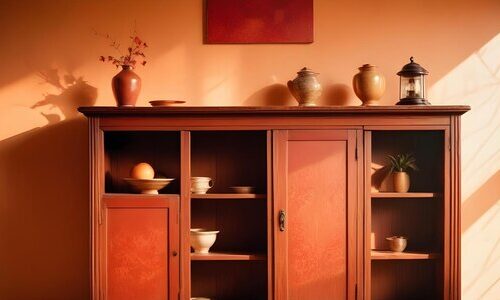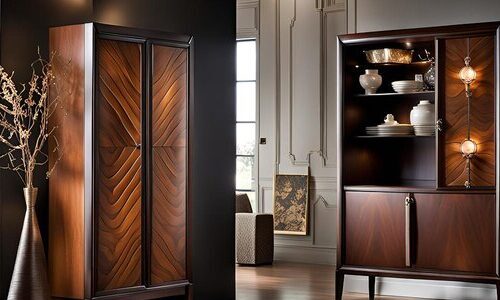
The Evolution of Wooden Almirahs: From Traditional to Contemporary
Wooden almirahs, or wardrobes, have been an essential part of homes across the globe for centuries, evolving in both form and function over time. From their origins as traditional, handcrafted storage pieces to today’s sleek, modern designs, wooden almirahs have remained a popular choice for homeowners due to their durability, aesthetic appeal, and versatility.
In this blog, we will take a deep dive into the evolution of wooden almirahs—exploring how these functional pieces have transformed from heavy, ornate designs to minimalist, contemporary furniture. We’ll also touch on the cultural significance of almirahs in different regions and how modern craftsmanship continues to reflect the timeless appeal of wood.
1. Traditional Wooden Almirahs: A Symbol of Craftsmanship and Heritage
Ornate Design and Craftsmanship
Traditional wooden almirahs were often large, imposing pieces of furniture, celebrated for their intricate carvings, rich textures, and detailed craftsmanship. In regions like India, Southeast Asia, and Europe, they were often crafted from premium hardwoods such as teak, rosewood, or mahogany. The use of these materials, combined with hand-carved details, made these almirahs not only functional but also works of art.
- Hand-carved Patterns: Traditional almirahs frequently featured detailed hand-carved patterns, often depicting floral or geometric motifs, religious symbols, or cultural references. These carvings added a sense of grandeur and opulence to the piece.
- Size and Presence: Traditional almirahs were often larger than modern counterparts, with imposing doors, intricate frames, and deep shelving. They commanded attention in a room and were often passed down through generations as heirlooms.
Cultural Significance
In many cultures, wooden almirahs were seen as more than just furniture. They were symbols of wealth, status, and cultural heritage. In Indian households, for instance, a large, ornately carved almirah was often part of a bride’s dowry. In Europe, almirahs were designed to store luxurious clothing and textiles, often reflecting the wealth of the owner.
- Storage of Valuables: Traditional almirahs were built with security in mind. Many featured lockable compartments, secret drawers, and sturdy frames, making them ideal for storing valuable items such as jewelry, cash, and important documents.
- Religious and Cultural Symbolism: The carvings on almirahs were often influenced by local culture and religion. For example, traditional Indian almirahs might feature Hindu deities or symbols of good fortune, while European designs could be inspired by Gothic or Baroque architectural elements.
2. Colonial Influence: A Blend of East and West
Fusion of Styles
The colonial period brought a fusion of design aesthetics, especially in regions where European powers held influence. This resulted in a unique blend of traditional craftsmanship with Western design sensibilities, creating what we now refer to as colonial-style wooden almirahs.
- Simplified Designs: While traditional almirahs were often highly ornate, colonial designs introduced a sense of restraint. The carvings were still present but subtler, focusing more on functionality than pure decoration.
- Material Choices: Colonial almirahs continued to use high-quality hardwoods like teak and mahogany, but the overall construction became lighter and more practical. These pieces were often designed with portability in mind, making them easier to move between homes or regions.
Functionality Meets Aesthetics
The influence of European design during the colonial era also led to a shift in how almirahs were used. Rather than being purely ornamental, these pieces became more practical, designed to store clothing, linens, and household items in a more organized fashion.
- Introduction of Drawers and Shelving: Colonial almirahs often included drawers, shelves, and hanging rods, catering to the evolving needs of households. These added elements helped maximize storage space, making the almirah more functional for daily use.
- Simpler Locking Mechanisms: While traditional almirahs were built with intricate locks, colonial designs featured simpler locking mechanisms, aligning with the growing emphasis on practicality and ease of use.
3. The Transition to Modern Almirahs
Minimalism and Functional Design
The industrial revolution and the subsequent rise of modern design brought significant changes to the look and feel of wooden almirahs. No longer designed solely as statement pieces, almirahs began to take on a more functional and minimalist appearance, aligning with the needs of modern households.
- Sleek, Minimalist Aesthetic: Modern wooden almirahs are often characterized by clean lines, smooth surfaces, and minimal detailing. Unlike their traditional counterparts, modern designs emphasize functionality over decoration.
- Lighter Materials: While traditional almirahs were often made from heavy hardwoods, modern almirahs use a combination of materials such as engineered wood, lighter timber, or plywood. This not only reduces the weight but also lowers costs, making them more accessible to a wider audience.
Customizable Storage Solutions
One of the hallmarks of modern almirahs is their customizable design. Today’s consumers can choose from a wide range of options, including modular compartments, sliding doors, and built-in mirrors, all tailored to fit individual storage needs.
- Modular Designs: Modern almirahs often feature adjustable shelving, pull-out drawers, and customizable hanging spaces, allowing homeowners to organize their belongings in a way that suits their lifestyle.
- Technology Integration: Some modern almirahs come with built-in lighting systems, soft-close hinges, and even digital locks for added security and convenience. These features make modern wooden almirahs more functional and user-friendly than ever before.
Sustainability and Eco-Friendly Materials
As environmental concerns have grown, there has been a significant shift toward using sustainable materials in the production of wooden almirahs. Many manufacturers now prioritize eco-friendly practices, such as using certified sustainable wood or reclaimed timber, to create beautiful yet responsible furniture pieces.
Reclaimed Wood: Some modern almirahs are made from reclaimed wood, giving new life to old materials and reducing the demand for newly harvested timber.
Low-VOC Finishes: Modern almirahs often use eco-friendly finishes, such as water-based varnishes or low-VOC paints, to minimize the environmental impact.

4. Contemporary Wooden Almirahs: Blending Tradition with Innovation
Customization and Personalization
One of the key trends in contemporary furniture design is personalization. Homeowners today can choose from a variety of customizable options when selecting an almirah, from the size and shape to the type of wood and finish.
- Built-in Features: Many contemporary almirahs come with built-in features such as mirrors, lighting, and hidden storage compartments, catering to the multifunctional needs of modern homes.
- Minimalist Yet Versatile: While contemporary almirahs often adhere to minimalist design principles, they are also incredibly versatile. They can be tailored to fit into various interior design styles, from Scandinavian and industrial to mid-century modern and bohemian.
Blending Old and New
Contemporary almirah designs often blend traditional craftsmanship with modern sensibilities. For instance, a contemporary wooden almirah might feature sleek, minimalist lines while still showcasing the natural beauty of the wood grain—a nod to traditional woodworking techniques.
- Textural Contrast: Some modern designs incorporate different textures, such as pairing natural wood with glass, metal, or lacquer, creating a striking contrast between materials that adds visual interest to the piece.
5. The Future of Wooden Almirahs
As interior design trends continue to evolve, the wooden almirah remains a staple in homes worldwide. With advancements in materials, craftsmanship, and technology, the future of almirah design looks promising, with a focus on sustainability, innovation, and personalization.
- Smart Storage Solutions: The future of wooden almirahs may include smart technology, such as built-in sensors to track clothing inventory or climate control features to protect delicate fabrics from humidity and pests.
- Sustainability at the Forefront: As consumers become more environmentally conscious, the demand for sustainable, eco-friendly furniture will continue to grow. Almirahs made from responsibly sourced wood, paired with eco-friendly finishes, will likely become the norm.
- A Return to Craftsmanship: While modern designs often prioritize functionality, there is also a growing appreciation for traditional craftsmanship. We may see a resurgence in handcrafted wooden almirahs that combine modern design elements with artisanal techniques.
FAQs
1. What are the advantages of choosing a wooden almirah over other materials?
Wooden almirahs offer a timeless appeal, exceptional durability, and can easily fit various decor styles. They are also customizable, making them ideal for those who want a unique piece of furniture that matches their personal style.
2. How can I maintain my wooden almirah?
Regular dusting, polishing, and avoiding direct sunlight exposure will help preserve your wooden almirah. It’s also recommended to use gentle, natural cleaning products to maintain the finish.
3. Can wooden almirahs be eco-friendly?
Yes, choosing sustainably sourced or reclaimed wood reduces the environmental impact. Additionally, eco-friendly finishes and responsible craftsmanship contribute to a more sustainable piece.
4. How do I choose between traditional and contemporary designs?
This depends on your personal style and home decor. Traditional designs work well in classic or rustic settings, while contemporary almirahs suit modern or minimalist spaces.
5. Are customized wooden almirahs more expensive?
Customized almirahs may be pricier than standard models due to the unique craftsmanship and materials involved. However, they offer a unique style and functionality that makes them a valuable investment.
Conclusion
The journey of wooden almirahs from traditional to contemporary styles reflects more than just changes in design; it mirrors shifts in lifestyle, values, and tastes. These iconic furniture pieces have evolved to meet the functional needs of modern living while preserving their classic appeal. From heirloom-quality antiques to sleek, minimalist designs, wooden almirahs continue to bring elegance, utility, and character into homes worldwide.
By choosing a wooden almirah—whether traditional or contemporary—you’re investing in a piece of furniture that offers both beauty and longevity. With the right selection, a wooden almirah can become a cherished addition to your home, providing style, organization, and a connection to timeless craftsmanship
